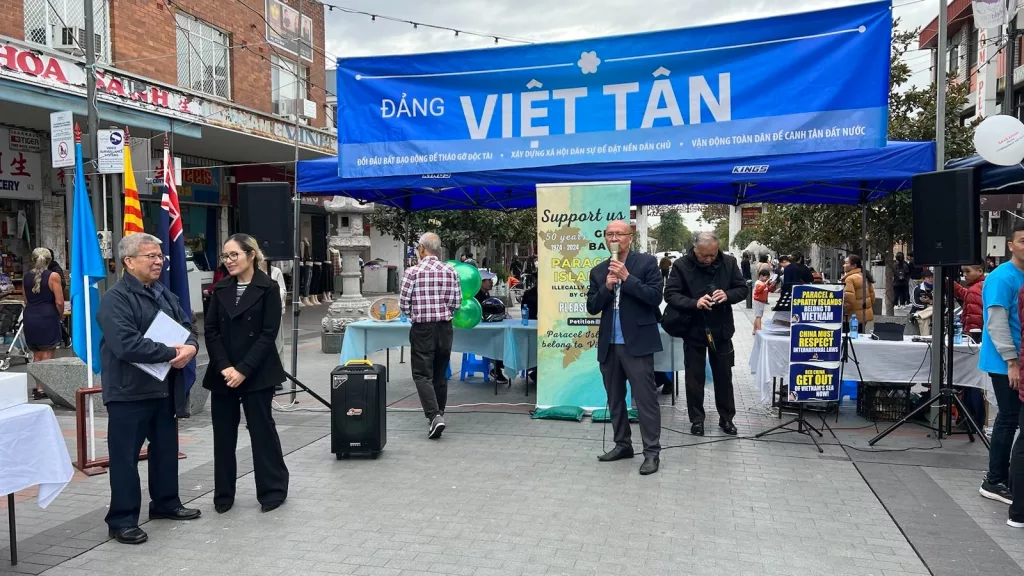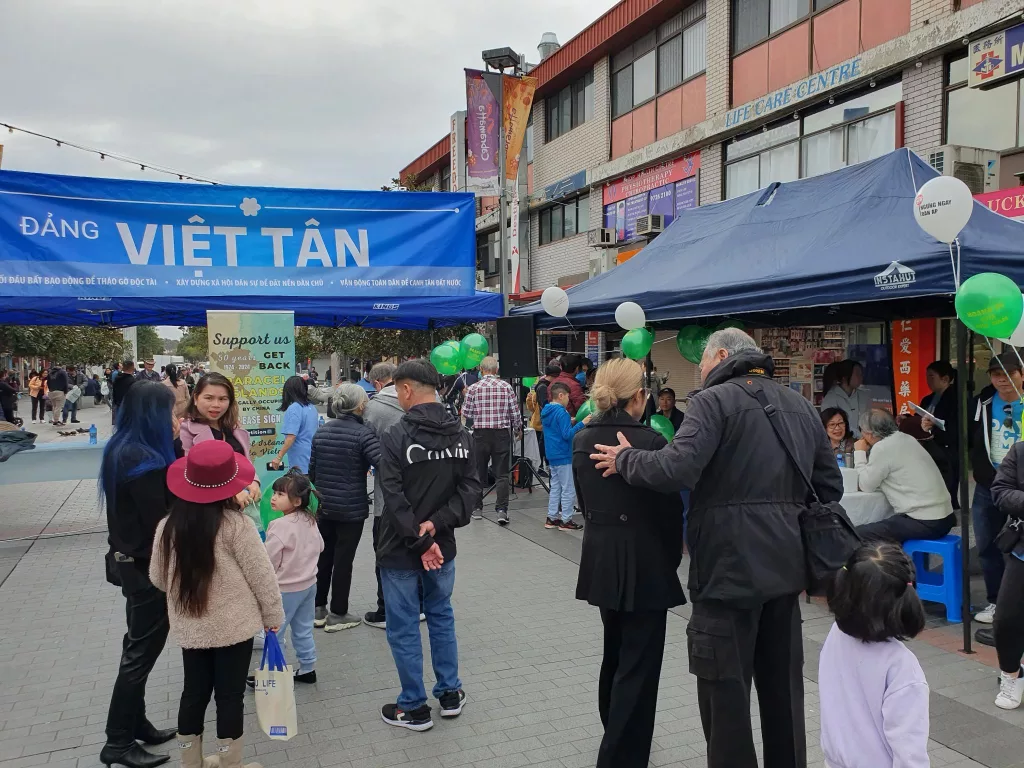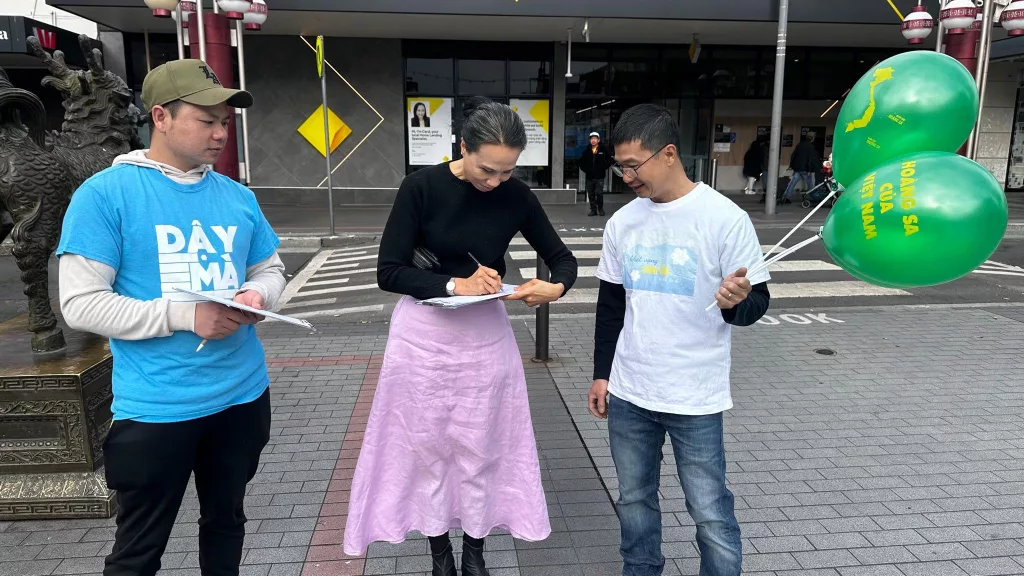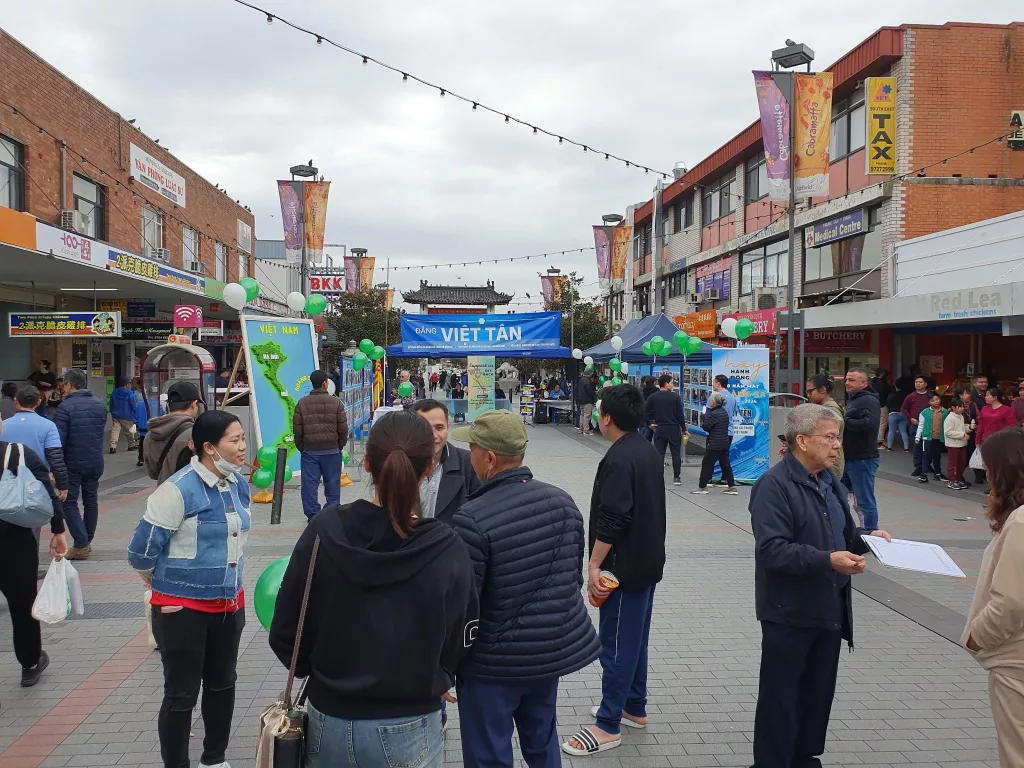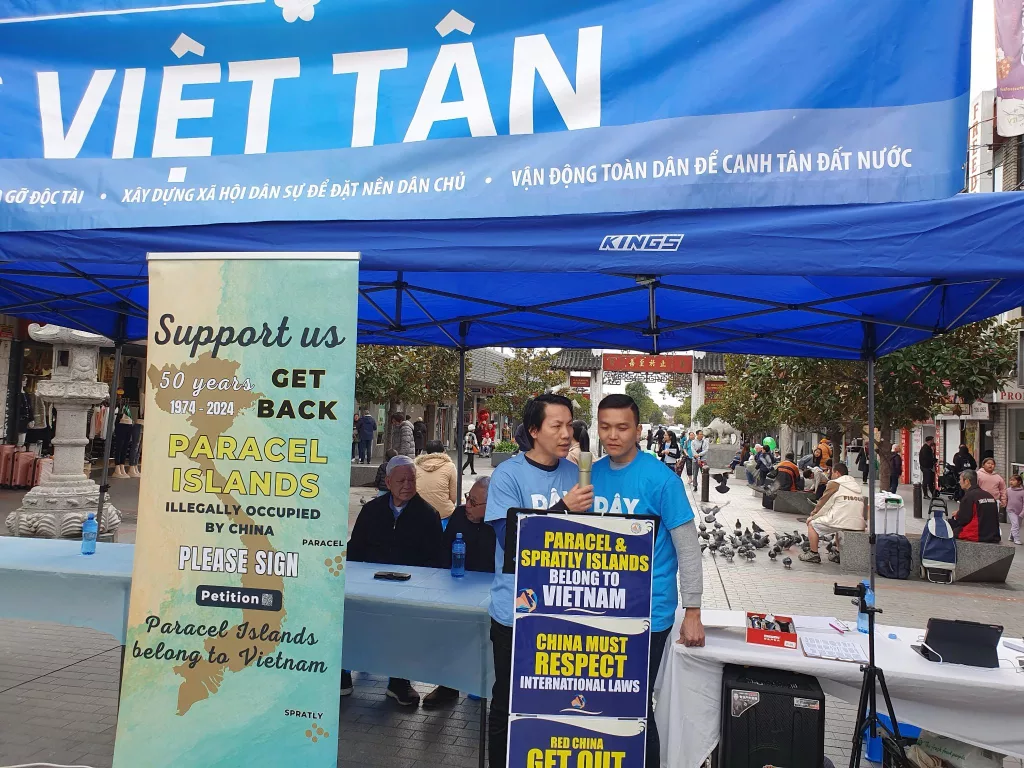“HS 50” từ nhóm Con Cháu Hai Bà
Trung Quốc vừa đưa ra tấm bản đồ mới, trong đó mở rộng khu vực TQ tuyên bố chủ quyền từ đường chín đoạn trước đây thành đường 10 đoạn, tức thêm một đoạn phía Đông đảo Đài Loan.
Bất chấp luật pháp quốc tế và phán quyết của Tòa Trọng Tài Quốc Tế Thường Trực (PCA) ở Hòa Lan, Trung Quốc ngang nhiên muốn nuốt chửng biển đảo của các nước trong vùng một cách phi pháp. Philippines, Malaysia, Đài Loan, Ấn Độ đều lên tiếng cực lực phản đối mưu đồ bành trướng của Trung Quốc.
Nhà cầm quyền CSVN cần phải thay đối chiến lược bảo vệ biển đảo VN, không chỉ lên tiếng lấy lệ vì nể sợ TQ mà phải kiện TQ ra toàn án quốc tế. Vì chỉ có như thế mới đáp ứng được nguyện vọng của người dân.
Đây là những tấm hình lên tiếng phản đối TQ chiếm giữ quần đảo Hoàng Sa gần 50 năm do nhóm Con Cháu Hai Bà thực hiện. Rất cảm kích nỗ lực của tấm lòng quyết bảo vệ chủ quyền biển đảo VN của anh chị em. Tiếc là ở đất nước này phải nhờ bạn bè bên ngoài đăng tải.
#baovechuquyen
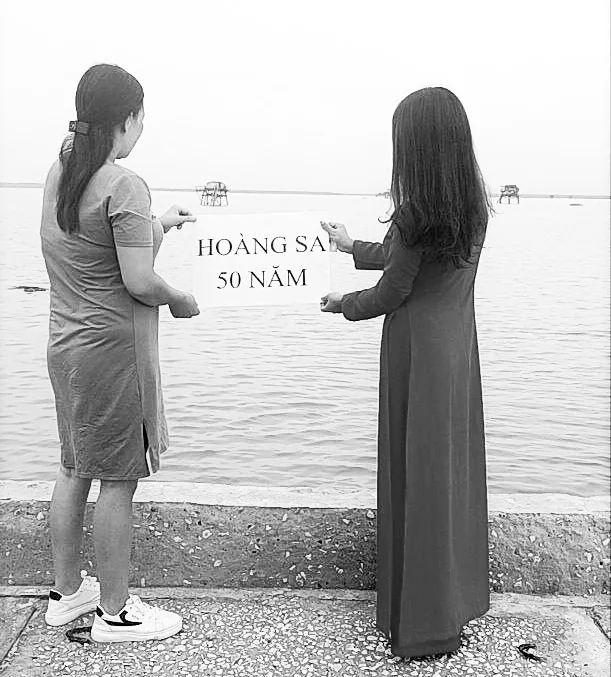
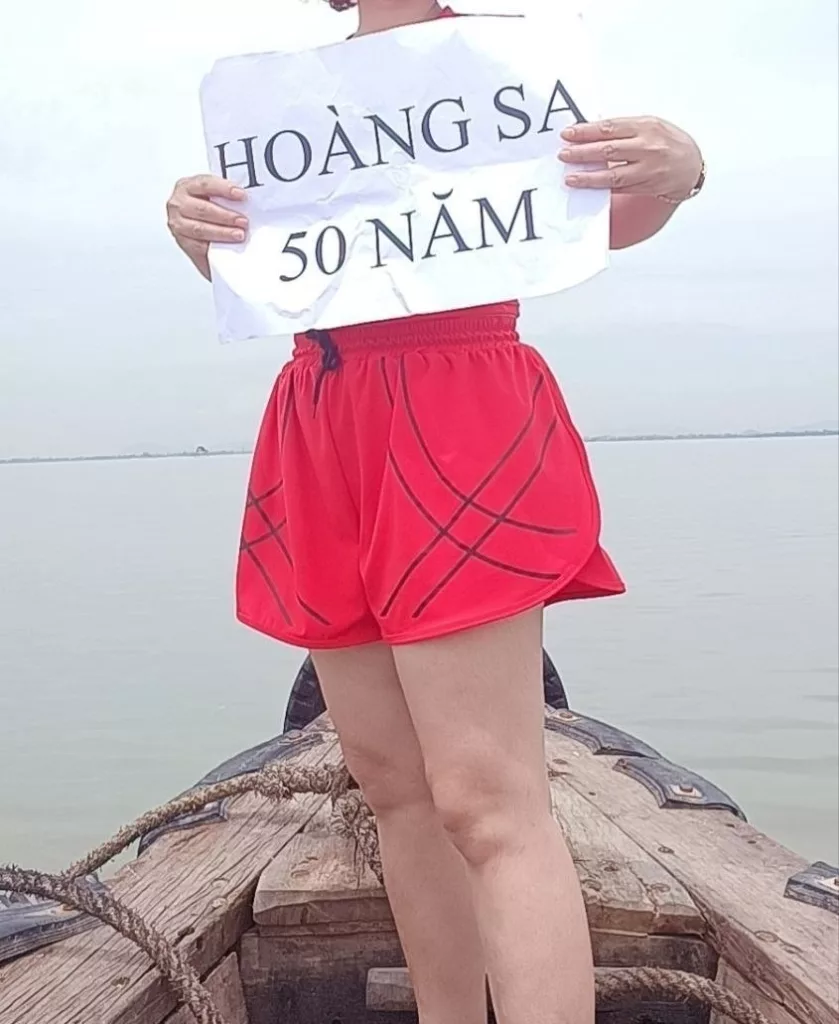
RFA – Chinese Coast Guard water cannon attack on Vietnamese fishing boat leaves 2 injured
Chinese Coast Guard vessel CCG 4201 fired a water cannon at Vietnamese fishing boat near the Paracel Islands in the South China Sea
Two Vietnamese fishermen were injured when a Chinese Coast Guard vessel fired a water cannon at their boat near the contested Paracel Islands, the latest casualties in China’s aggressive campaign to expand its control in the South China Sea.
Tuesday’s incident, ahead of U.S. President Joe Biden’s visit to Vietnam on Sept. 10, happened as the fishing boat was moving from Woody Island to Observation Bank in the waters surrounding the Paracels, Vietnamese state media reported.
The ship’s owner, Huynh Van Hoanh, 43, suffered a broken right arm while fisherman Huynh Van Tien sustained a head injury during the attack by Coast Guard ship 4201.
The Paracel Islands, known as the Xisha Islands in Chinese and the Hoàng Sa Archipelago in Vietnamese, comprise about 130 small coral islands and reefs.
Claimed by China, Vietnam and Taiwan, they have been occupied entirely by Beijing since 1974 after the Chinese navy defeated the then-South Vietnamese navy in a brief sea battle. Triton is the closest island in the chain to Vietnam.
Researcher Nguyen The Phuong from the University of New South Wales in Canberra, Australia, said he expected to see more tensions between China and Vietnam in the South China Sea as the date of Biden’s trip approached.
Regardless of whether Vietnam and the U.S. upgrade their relationship to a “comprehensive strategic partnership” or “strategic partnership,” China will continue its maritime strategy of “rocking the tree to threaten the monkey,” he said.
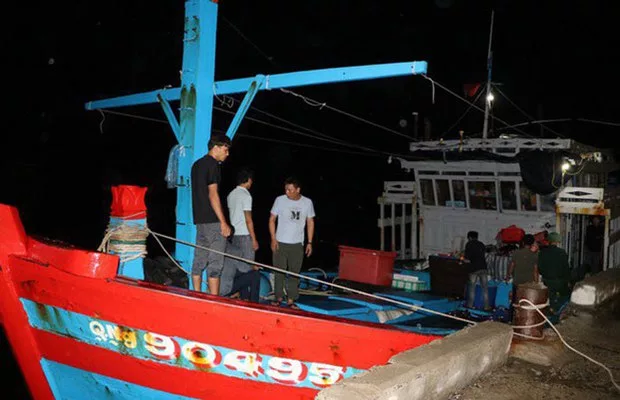
The Vietnamese fishing boat QNg 90495T is seen in port after it was attacked with a water cannon by Chinese Coast Guard vessel CCG 4201 near the Paracel Islands in the South China Sea, Aug. 29, 2023.
Marine Traffic data
Meanwhile, the same Chinese Coast Guard vessel and an unspecified Vietnamese boat, Ly Son 62908, have been chasing each other since Aug. 19 in the waters around Triton Island, where China recently built a 600-meter (2,000-foot) military airstrip.
China’s Coast Guard in recent years has ramped up its attacks on Vietnamese fishing boats by ramming them or firing water cannons to assert Beijing’s territorial claims in the resource-rich waters of the South China Sea.
The Coast Guard ship was operating in the middle of the Paracel Islands on the day of the attack, according to the automatic identification system, or AIS, data from maritime analytics provider Marine Traffic. The self-reporting system lets vessels broadcast their identification information, characteristics and destination.
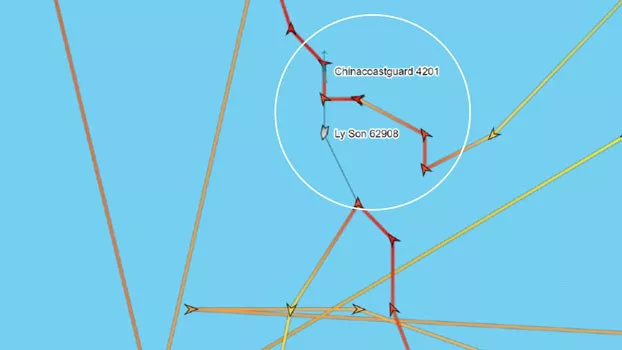
The Vietnamese boat Ly Son 62908 was once only 300 meters from the Chinese coast guard vessel CCG 4201 near Triton Island in the South China Sea, Aug. 25, 2023. Credit: MarineTraffic.com
Raymond Powell of the Gordian Knot Center for National Security Innovation at Stanford University and a former U.S. defense official, told Radio Free Asia that the position of the Coast Guard vessel coincided with the location of the attack reported by the fishing boat owner.
Marine Traffic data also indicated that the second Vietnamese ship had been moving around Triton Island. Since Aug. 19, the Coast Guard ship and Vietnam’s Ly Son 62908 have been following each other closely, and at one time were only 300 meters (1,000 feet) apart in distance.
On Aug. 27, the Chinese Coast Guard ship left the Triton Island area, headed northeast and arrived in the middle of the Paracel Islands, where it assaulted the other Vietnamese fishing boat, QNg 90495TS, two days later.
After the attack, the Coast Guard ship returned to the Triton Island area and continued the chasing game with Vietnam’s ship, Ly Son 62908. To date, the two ships are still following each other in the area.
Into the zone
Researcher Hoang Viet pointed out that China has intensified its aggressive actions since a phone conversation between U.S. President Joe Biden and Vietnamese General Secretary Nguyen Phu Trong in March and the visit to Vietnam by U.S. Secretary of State Antony Blinken in mid-April.
China had repeatedly sent its survey ship Xiang Yang Hong 10 into Vietnam’s exclusive economic zone, which extend 200 nautical miles (230 miles) beyond a nation’s territorial sea, he said.
Powell told RFA he believed it was a small militia vessel, and that the fishing boat had gone further east than the regular route of Vietnamese Coast Guard or militia ships. He also said although Vietnam claimed sovereignty over the Paracel Islands, it rarely sent security vessels to the middle of this archipelago.
“In fact, I’ve never seen them do that,” he said.
The attack on the fishing boat also followed an Aug. 5 incident in which a Chinese Coast Guard ship shot water cannons at a Philippine boat en route to providing food and supplies to Philippine forces on the Second Thomas Shoal.
RFA 01/09/2023
VOA – Việt Nam phản đối vụ tàu hải cảnh Trung Quốc tấn công tàu cá ngư dân Quảng Ngãi
Đại diện Bộ Ngoại giao Việt Nam hôm 31/8 lên tiếng phản đối hành vi sử dụng vũ lực đối với tàu cá của ngư dân Việt Nam, hai ngày sau khi một số ngư dân Quảng Ngãi cho biết tàu cá của họ bị tàu hải cảnh Trung Quốc tấn công bằng vòi rồng khi đang hành nghề ở khu vực thuộc quần đảo Hoàng Sa, dẫn đến hai ngư dân bị thương.
“Việt Nam phản đối mọi hành vi sử dụng vũ lực đối với các tàu cá của Việt Nam hoạt động bình thường trên biển, đe doạ đến tính mạng và an toàn cũng như gây thiệt hại về tài sản và lợi ích của ngư dân, trái với luật pháp quốc tế, Công ước của Liên hợp quốc về Luật Biển 1982”, người Phát ngôn Bộ Ngoại giao Việt Nam Phạm Thu Hằng nói tại buổi họp báo hôm 31/8.
Bà Hằng cho biết thêm rằng hiện các cơ quan chức năng Việt Nam đang “khẩn trương làm rõ vụ việc”.
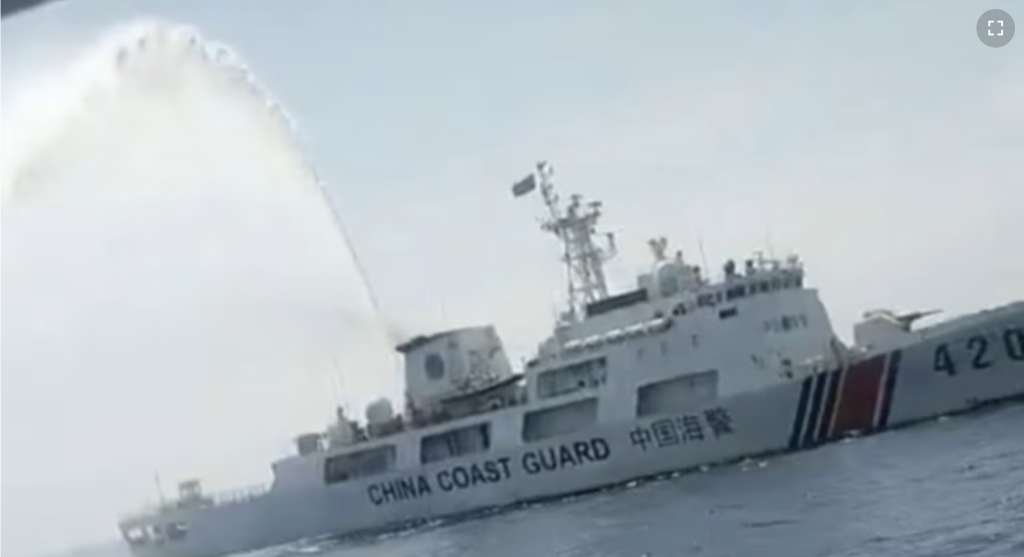
Hình: Tàu mang cờ hiệu Trung Quốc phun vòi rồng vào tàu cá của ngư dân Quảng Ngãi. Ảnh do ngư dân cung cấp cho báo Thanh Niên.
Trước đó, hôm 30/8, truyền thông Việt Nam dẫn lời khai của các ngư dân ở Quảng Ngãi cho hay tàu cá QNg 90495 TS của họ, với 10 thuyền viên trên tàu, khi đang di chuyển từ đảo Phú Lâm đến bãi Xà Cừ (thuộc quần đảo Hoàng Sa) để đánh bắt vào ngày 28/8, đã bị một tàu mang cờ hiệu Trung Quốc số 4201 áp sát và liên tục dùng vòi rồng tấn công suốt từ 5 giờ sáng đến 3 giờ chiều.
Các ngư dân cho biết tàu hải cảnh của Trung Quốc cố dùng vòi rồng để làm cho tàu cá của các ngư dân chết máy và tìm cách lên tàu cá nhưng không thành công.
Vụ tấn công đã làm cho tàu cá của các ngư dân bị hư hỏng rất nặng, nhiều chỗ trên tàu làm bằng gỗ và kính bị vỡ vụn, các thiết bị hàng hải bị cháy và hư hỏng. Một thuyền viên bị gãy tay và một thuyền viên khác bị chấn thương vùng đầu.
Theo Straits Times, đây chỉ là một trường hợp tiêu biểu cho thấy các tàu hải cảnh của Trung Quốc đang tăng cường thực thi các yêu sách lãnh thổ trong những năm gần đây, với nhiều vụ đuổi bắt, tấn công các tàu cá của ngư dân Việt Nam. Tờ báo của Singapore trích dẫn số liệu của hiệp hội đánh cá địa phương, cho biết kể từ năm 2014, đã có 98 tàu thuyền Việt Nam bị tàu Trung Quốc phá hủy.
Philippines, một quốc gia có tranh chấp khác ở Biển Đông, cũng đã lên tiếng phản đối Trung Quốc về các cuộc tấn công bằng vòi rồng trong những tháng gần đây. Hồi tháng 2, Manila cho biết một tàu Trung Quốc trong một cuộc đối đầu đã dùng “tia laser cấp quân sự” khiến cho một thủy thủ trên tàu của lực lượng tuần duyên Philippines bị “mù mắt tạm thời”.
Để đối phó với Trung Quốc, chính phủ Hoa Kỳ đang thắt chặt liên minh với các đối tác trong khu vực, bao gồm Nhật Bản, Hàn Quốc, Việt Nam và Philippines, nhằm ngăn chặn chủ nghĩa bành trướng của Bắc Kinh, nhất là trong khu vực Biển Đông.
Trong cuộc phỏng vấn gần đây với Reuters, Tư lệnh Hạm đội 7 của Mỹ, Đô đốc Karl Thomas, nói rằng cần phải đẩy lùi “hành vi hung hăng” của Trung Quốc trên biển.
Mang thông điệp HS50 đến trước trụ sở Liên Hiệp Quốc tại Geneva – Thụy Sĩ
Một nhóm người Việt tại Thụy Sĩ đã mang thông điệp HS50 đến trước trụ sở Liên Hiệp Quốc tại Geneva để kêu gọi cộng đồng thế giới công nhận Hoàng Sa là của Việt Nam và bảo vệ các ngư dân Việt Nam trước sự hung hăng của Trung Quốc.
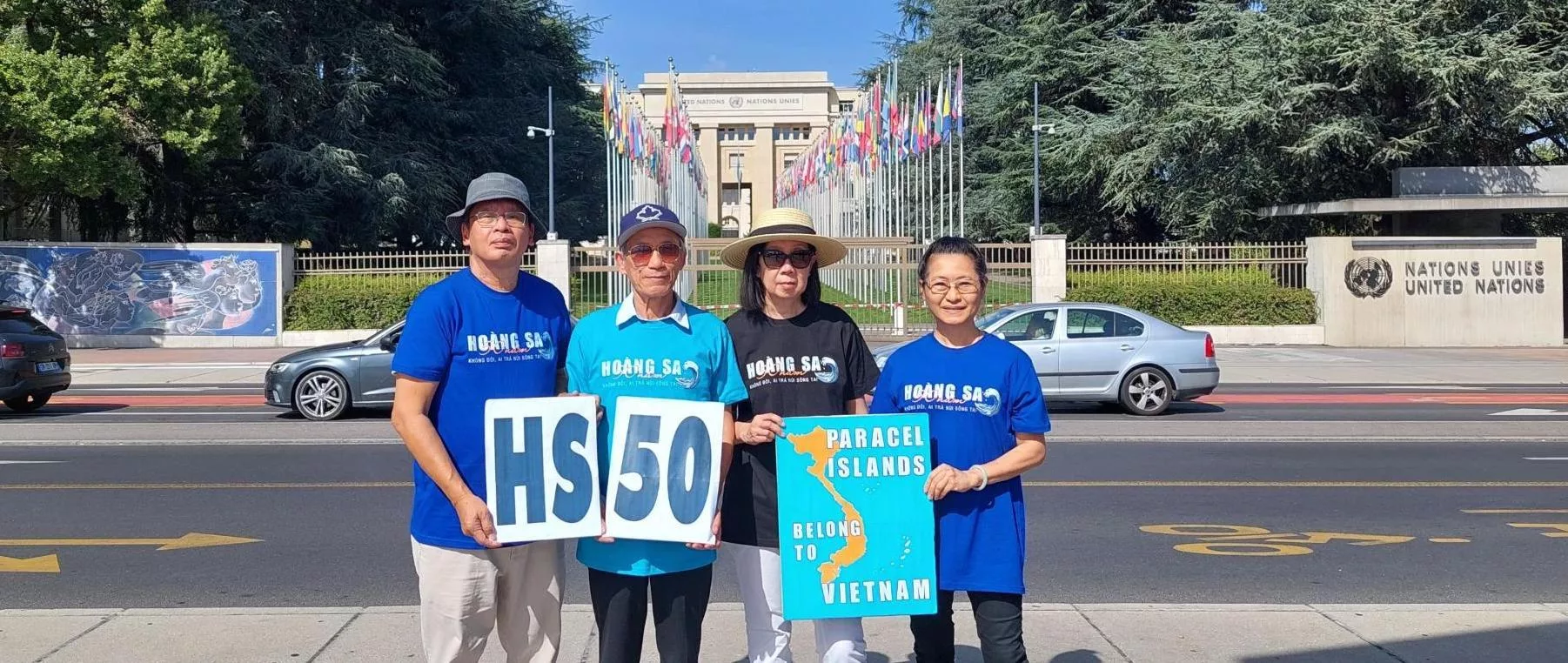
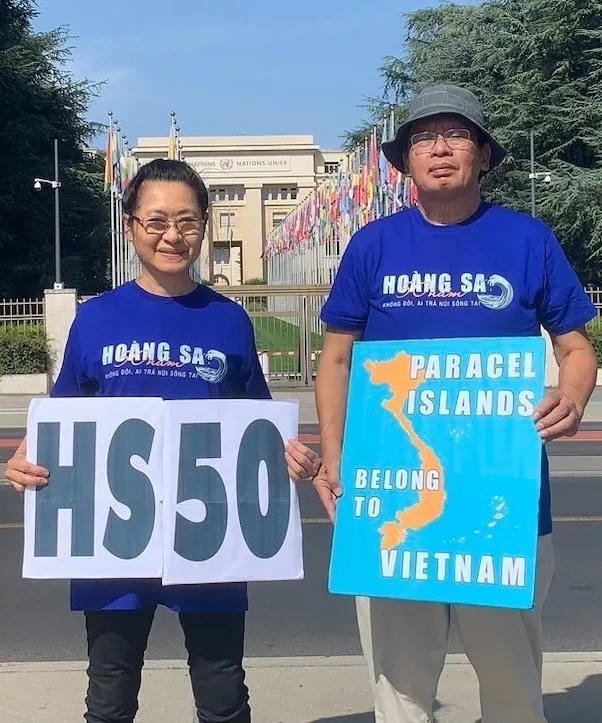
Hãy cùng góp tiếng nói của bạn bằng cách ký tên vào kiến nghị thư “Hoàng Sa Thuộc Việt Nam” để lên án Trung Quốc vi phạm luật pháp quốc tế, đe dọa hòa bình chung và kêu gọi thế giới có hành động để bảo vệ ngư dân ở Biển Đông.
#HS50
La Chine construit une nouvelle piste d’atterrissage en mer de Chine méridionale
Il s’agit du dernier exemple de militarisation de la mer de Chine méridionale, un processus en cours depuis plusieurs années, qui a reçu une impulsion particulière sous la présidence de Xi Jinping.
La Chine construit une nouvelle piste d’atterrissage sur l’île Triton, dans l’archipel de Paracelse, dans une zone de la Mer de Chine méridionale dont la souveraineté est également revendiquée par le Vietnam et Taïwan. C’est ce qu’a rapporté le journal hongkongais “South China Morning Post” sur la base d’images satellite datant de la mi-juillet. Triton est l’île la plus méridionale et la plus occidentale (et donc la plus proche du Vietnam) des îles Paracelse, que les Chinois appellent Xisha et les Vietnamiens Hoang Sa. C’est le dernier exemple en date de la militarisation de la mer de Chine méridionale, un processus en cours depuis plusieurs années, qui a reçu une impulsion particulière sous la présidence de Xi Jinping à Pékin et qui a déjà vu la Chine construire des fortifications et des structures militaires entre les îlots et les atolls des Paracelse et des Spratleys, plus près de la côte des Philippines. Ici, en particulier, Pékin a construit des pistes d’atterrissage sur les atolls de Fiery Cross et Mischief.
Dans le passé, les médias d’État chinois avaient déjà publié des informations sur les activités militaires sur l’île de Triton, où des missions d’entraînement sont menées pour la marine et où des jardins sont également cultivés. Ici, la Chine a déjà installé un héliport, plusieurs bâtiments, des systèmes radar, un terrain de basket et un petit port. La nouvelle piste, rapporte le “South China Morning Post”, apparaît longue de 630 mètres, plus courte que les autres construites dans la région, et est donc capable d’accueillir un nombre limité de modèles d’avions militaires. Celui de Fiery Cross (appelé Yonghsu Jiao par les Chinois) est long de 3 kilomètres et permet l’atterrissage et le décollage des bombardiers H-6 fournis à l’Armée populaire de libération de Pékin. Les mêmes images satellites montrent également la construction d’un nouveau bâtiment à environ 100 mètres au sud de la piste, à laquelle il est relié par une route. L’île Triton est de petite taille mais les eaux autour de l’archipel sont riches en ressources naturelles et sont traversées par un trafic commercial intense.
La nouvelle de Paracelse devrait encore attiser les tensions dans la région, au lendemain d’une rencontre à Kunming entre le ministre chinois des Affaires étrangères Wang Yi et le vice-Premier ministre vietnamien Tran Luu Quang, au cours de laquelle Pékin a invité Hanoï à “protéger les idéaux du Parti communiste et les directives socialistes”, rejetant “l’ingérence” de forces extérieures. La référence apparaît notamment au président philippin Ferdinand Marcos Junior, qui s’est dit la semaine dernière prêt à travailler sur un accord avec le Vietnam visant à rejeter les revendications territoriales chinoises dans la région.
Wang, qui a repris le poste de ministre des affaires étrangères en juillet dernier pour remplacer Gang de Qin (dont on est sans nouvelles depuis des semaines), il a rappelé que la Chine et le Vietnam sont des voisins “liés par des idéologies similaires” et devraient jeter les bases “d’une nouvelle phase d’échanges de haut niveau”.
“Nous devons conjointement sauvegarder la sécurité du régime et des institutions, protéger les idéaux et les croyances du Parti et les directives socialistes”, a déclaré M. Wang lors de la réunion, selon le rapport offert par le ministère chinois des Affaires étrangères. Le chef de la diplomatie de Pékin a également promis que la Chine travaillerait avec les pays de l’Association des nations de l’Asie du Sud-Est (ASEAN), y compris le Vietnam, « pour s’opposer à l’ingérence provocatrice des forces extérieures et pour maintenir la paix et la stabilité en mer de Chine méridionale et dans la région ». . Les tensions dans la région ont de nouveau éclaté la semaine dernière après qu’un navire des garde-côtes de Pékin a tiré des canons à eau sur un navire de la marine philippine dans l’archipel des îles Spratly, incitant Marcos à protester officiellement auprès de l’ambassadeur de Chine à Manille. La Chine et les dix pays de l’ASEAN devraient cependant relancer la semaine prochaine, précisément aux Philippines, les négociations sur l’élaboration d’un code de conduite pour les navires en transit en mer de Chine méridionale.
Toujours selon le rapport chinois de la réunion, Quang a réitéré que les relations avec la Chine ont « une signification particulière » pour le Vietnam et que les relations bilatérales « sont toujours la première priorité » pour Hanoï. “Le Vietnam – a-t-il ajouté – s’oppose à toute forme d’ingérence étrangère et renforcera les échanges de haut niveau avec la Chine, pour approfondir la coopération pratique dans tous les secteurs”. Le ministre vietnamien s’est rendu à Kunming pour participer à l’Exposition Chine-Asie du Sud, l’une des nombreuses initiatives lancées par Pékin pour renforcer les relations avec les pays d’Asie du Sud-Est. Parmi ceux-ci figure également le voyage entrepris la semaine dernière par Wang dans la région, avec des escales à Singapour, en Malaisie et au Cambodge. Selon des rumeurs de presse, dans un avenir proche, il pourrait également y avoir de la place pour une visite du président Xi Jinping au Vietnam.
Nouvelles Nova
AP – China appears to be building an airstrip on a disputed South China Sea island
China appears to be constructing an airstrip on a disputed South China Sea island that is also claimed by Vietnam and Taiwan, according to satellite photos analyzed by The Associated Press.
The work on Triton island in the Paracel group mirrors construction on seven human-made islands in the Spratly group to the east which have been equipped with airstrips, docks and military systems, although it currently appears to be somewhat more modest in scale.
China claims virtually the entire South China Sea as its own, denying the claims of others and defying an international ruling invalidating its assertion.
Satellite photos from Planet Labs PBC analyzed by the AP show construction on the airstrip first visible in early August. The runway, as currently laid out, would be more than 600 meters (2,000 feet) in length, long enough to accommodate turboprop aircraft and drones, but not fighter jets or bombers.
Also visible are large numbers of vehicle tracks running across much of the island, along with what appear to be containers and construction equipment.
Triton is one of the major islands in the Paracel group, which is roughly equidistant from the coast of Vietnam and China’s island province of Hainan.
The U.S. takes no stance on the sovereignty claims, but regularly sends Navy ships on “freedom of navigation operations” near the Chinese-held islands. Triton was the focus of one of those missions in 2018.
China has had a small harbor and buildings on the island for years, along with a helipad and radar arrays. Two large fields on the island sport a star from the Chinese flag and a hammer and sickle representing the ruling Communist Party.
China has refused to provide details of its island construction work other than to say it is aimed at helping global navigation safety. It has rejected accusations that it is militarizing the crucial waterway, through which an estimated $5 trillion in trade passes annually, and says it has the right to do as it wishes in its sovereign territory.
China seized full control of the Paracels from Vietnam in a brief 1974 naval conflict.
AP 18/08/2023
Trung Quốc đang xây dựng phi đạo trên một đảo tranh chấp ở Biển Đông
Theo các bức ảnh vệ tinh được hãng thông tấn AP phân tích Trung Quốc dường như đang xây dựng một phi đạo trên đảo Tri Tôn ở quần đảo Hoàng Sa, mà Trung Quốc đã ngang nhiên đánh chiếm của Việt Nam vào năm 1974.
Theo AP, công trình trên đảo này tương tự như các hoạt động xây dựng trên bảy đảo nhân tạo ở quần đảo Trường Sa, với các phi đạo, bến tàu và hệ thống quân sự, tuy nhiên quy mô hiện nay có vẻ khiêm tốn hơn.
Các bức ảnh vệ tinh của Planet Labs PBC được AP phân tích cho thấy việc xây dựng phi đạo có thể nhìn thấy lần đầu tiên vào đầu tháng 8. Phi đạo, như hiện đang được bố trí, sẽ có chiều dài hơn 600 mét (2.000 feet), đủ dài cho máy bay cánh quạt và máy bay không người lái, nhưng không đủ cho máy bay chiến đấu hoặc máy bay ném bom.
Ngoài ra còn có thể nhìn thấy một số lượng lớn đường cho xe chạy qua phần lớn hòn đảo, cùng với những gì trông có vẻ như là container và thiết bị xây dựng.
Tri Tôn là một trong những hòn đảo lớn trong quần đảo Hoàng Sa. Khoảng cách đảo này với bờ biển Việt Nam bằng với khoảng cách từ đảo này với đảo Hải Nam của Trung Quốc.
Trung Quốc đã xây một bến cảng nhỏ và các tòa nhà trên đảo Tri Tôn cách nay nhiều năm, cùng với một sân bay trực thăng và các mảng radar. Hai cánh đồng lớn trên đảo có ngôi sao vàng của cờ Trung Quốc và búa liềm tượng trưng cho Đảng Cộng sản cầm quyền.
Trung Quốc đã từ chối cung cấp thông tin chi tiết về việc xây dựng đảo ở Biển Đông ngoài việc nói rằng nó nhằm mục đích giúp bảo đảm an toàn hàng hải toàn cầu. Tuy nhiên thế giới nhìn thấy rõ mục tiêu của Bắc Kinh đó là quân sự hóa tuyến đường thủy quan trọng, nơi có khoảng 5 ngàn tỷ mỹ kim thương mại đi qua hàng năm.
Để đối phó với việc Trung Quốc tuyên bố chủ quyền trên gần hết Biển Đông, Hoa Kỳ thường xuyên cử các tàu Hải quân thực hiện “các hoạt động tự do hàng hải” gần các đảo do Trung Quốc chiếm giữ.
Giới Trẻ Việt Nam Vận Động Cho Kiến Nghị Hoàng Sa Thuộc Việt Nam
Tại trại hè cho giới trẻ Việt Nam do Mạng Lưới Đồng Hành tổ chức trong tháng 7 vừa qua tại Đan Mạch, hơn 50 bạn trẻ đã cùng nhau tìm hiểu và trao đổi về vấn đề Biển Đông nói chung và chủ quyền của Việt Nam đối với hai quần đảo Hoàng Sa và Trường Sa nói riêng.
Các bạn trẻ Việt Nam đến từ nhiều nơi trên thế giới cũng đã cùng nhau chia sẻ học hỏi thêm về văn hoá, con người và đất nước Việt Nam.
Do những liên quan với tình hình thế giới nên vấn đề Biển Đông, đặc biệt vấn đề chủ quyền biển đảo của Việt Nam và sự an nguy của các ngư dân ở quê nhà trong các vùng biển Hoàng Sa, Trường Sa là những điều tạo sự quan tâm nhiều nhất nơi các bạn trẻ.
HOÀNG SA 50 NĂM – KHÔNG ĐÒI, AI TRẢ NÚI SÔNG TA! dòng chữ trên chiếc áo t-shirt của những bạn trẻ như một chứng minh rằng mọi con dân Việt Nam cho dù ở nơi nào cũng luôn hướng về quê hương cội nguồn.




HS50: Thông điệp Hoàng Sa Thuộc Việt Nam
Lịch sử Việt Nam hào hùng với những chiến công oanh liệt chống quân xâm lược Phương Bắc. Qua bao đời dân tộc Việt Nam luôn bày tỏ lòng yêu nước, quyết tâm giữ từng tấc đất, chấp nhận bao hy sinh vì sự tự do và độc lập của quê hương.
Những tấm gương anh hùng Ngô Quyền, Trần Hưng Đạo, Lê Lợi… là nguồn cảm hứng cho các thế hệ tiếp nối.
Trong quá khứ, dân tộc Việt Nam đã có nhiều biện pháp sáng tạo để truyền tải thông điệp và kêu gọi đồng lòng chống giặc ngoại xâm.
Noi gương cha ông bạn trẻ Đồng Sáu đã thể hiện tinh thần dân tộc, bảo vệ chủ quyền lãnh thổ bằng một việc làm rất đơn giản mà đầy ý nghĩa… đó là viết chữ HS50 lên trên lá cây.
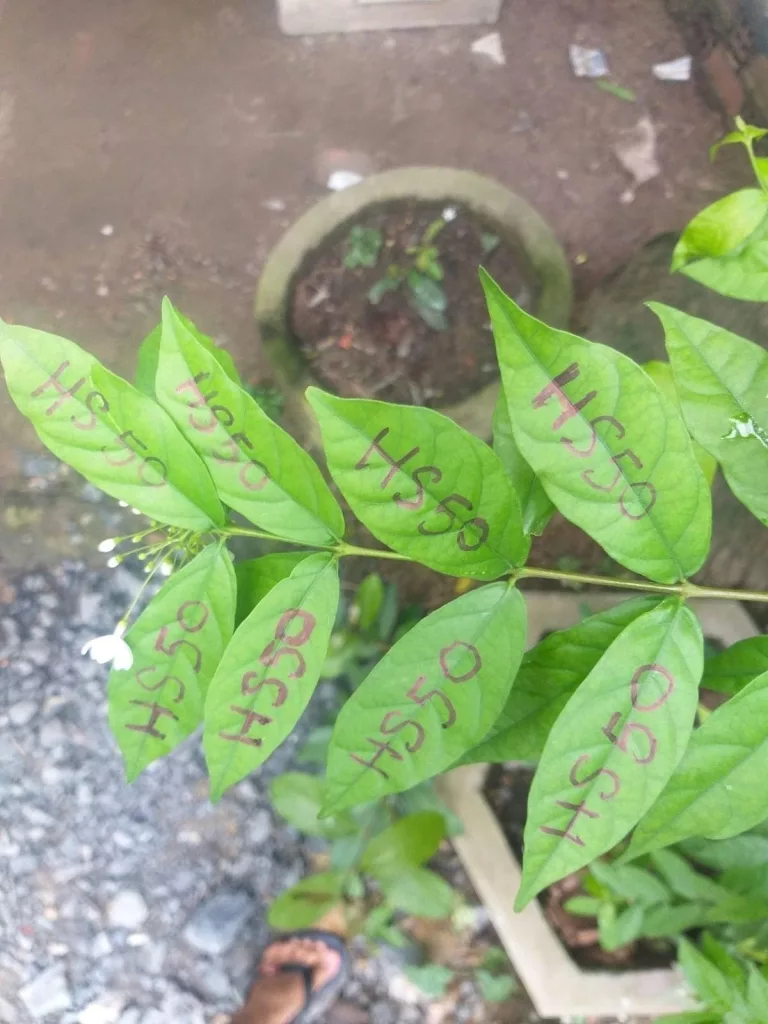
Nhiều bạn trẻ khác viết lên nón, trên cột điện, cắt giấy…
Tất cả đều cùng xuất phát từ lòng yêu nước thương quê hương.
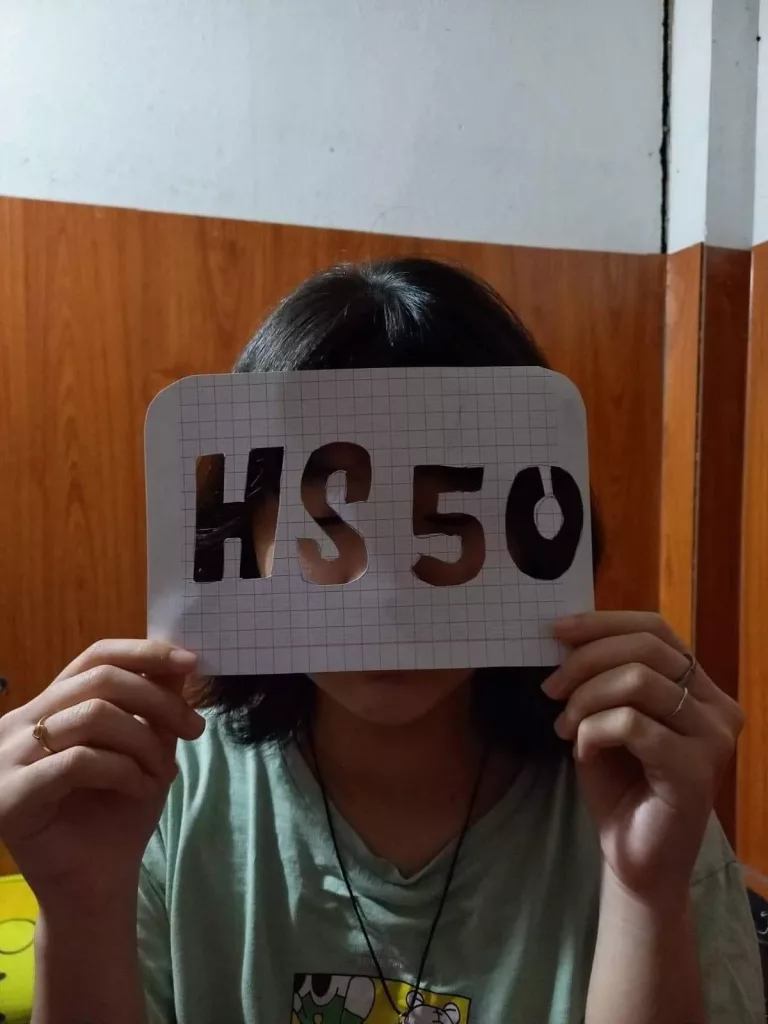
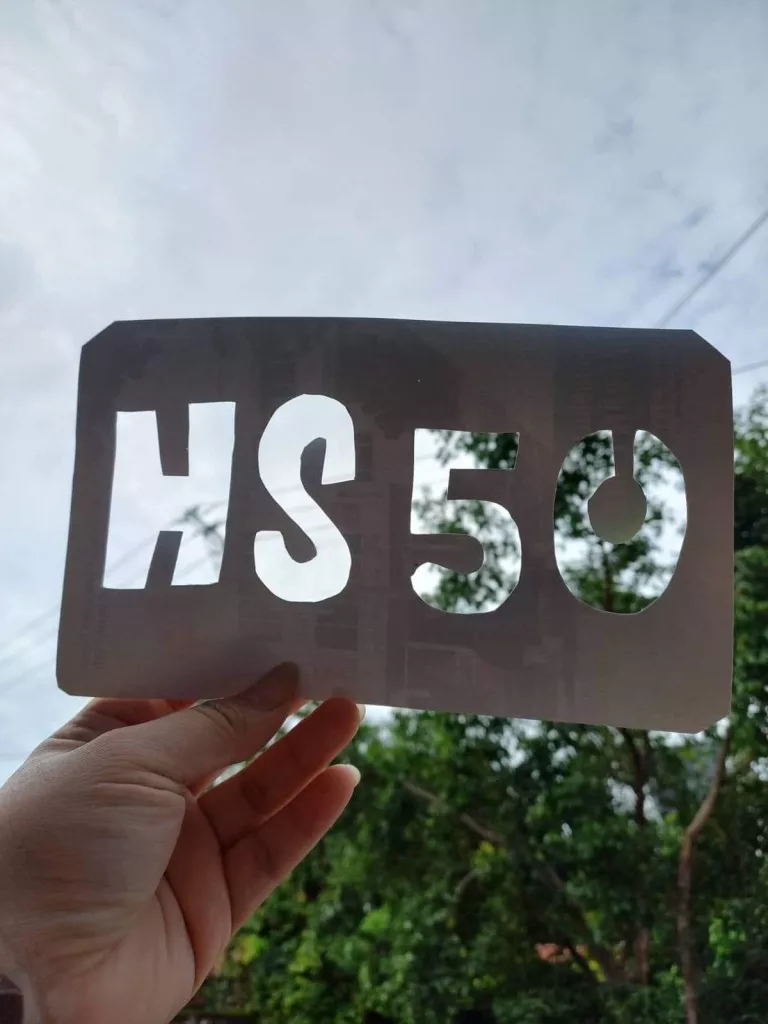
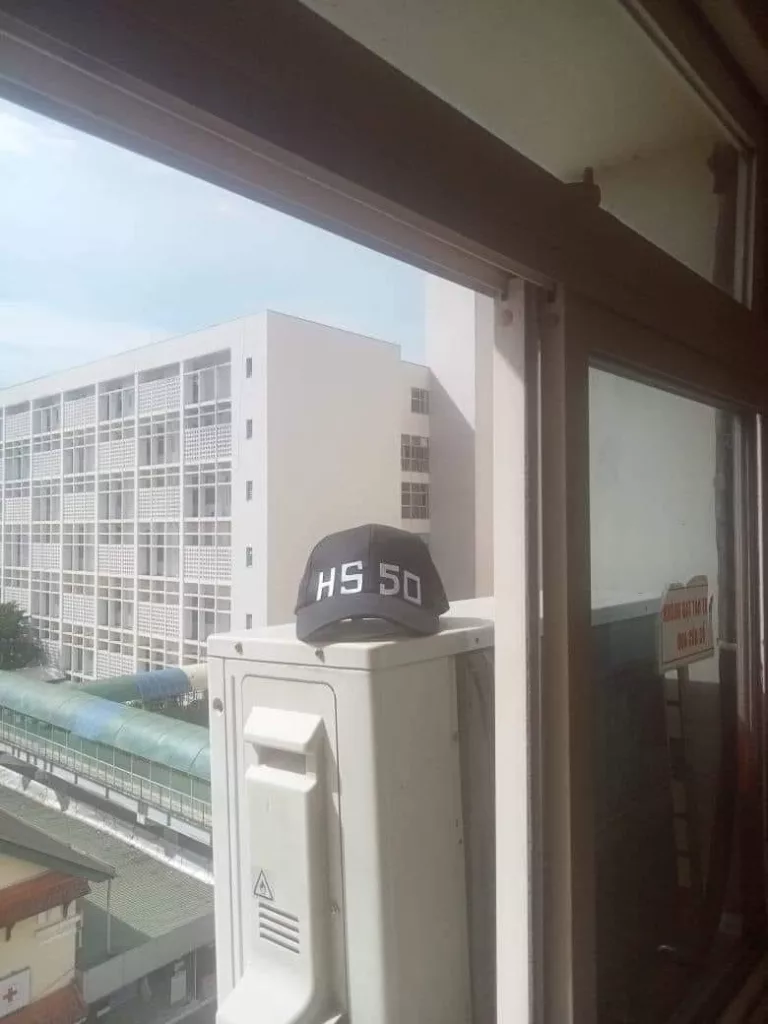
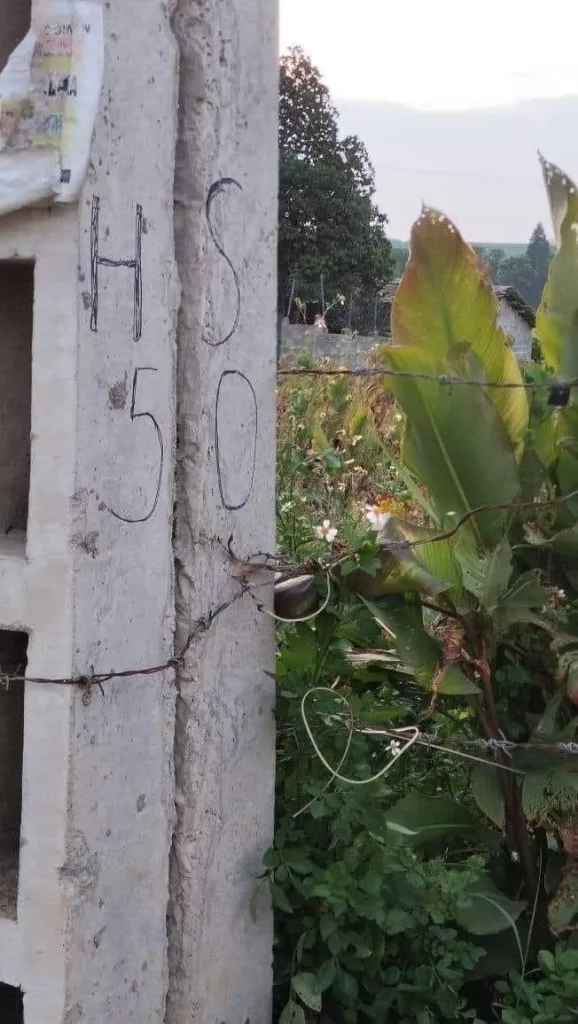
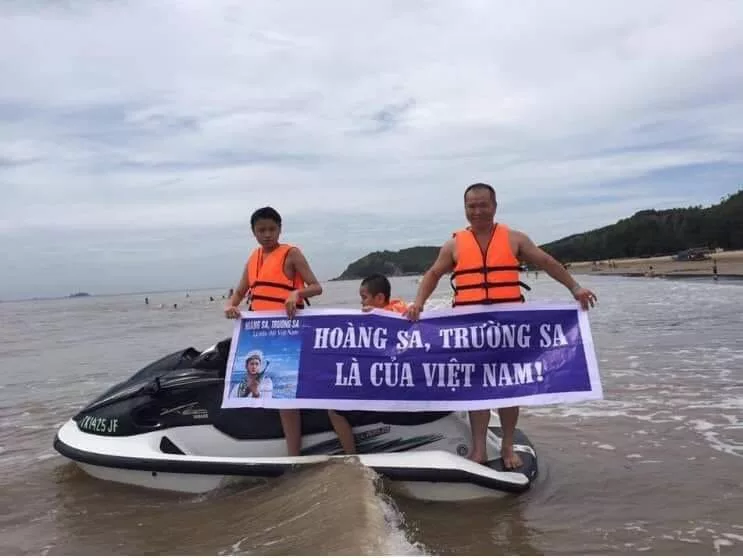
Lên tiếng bảo vệ chủ quyền lãnh thổ là trách nhiệm, bổn phận của mỗi chúng ta – con dân Việt Nam.
Hãy cùng đồng lòng, chung sức. Hãy lên tiếng theo cách của bạn. Hãy nói với mọi người: HOÀNG SA THUỘC VIỆT NAM
#HS50 #baovechuquyen
Sydney: Les membres de Viet Tan se mobilisent pour collecter des signatures pour la pétition sur les îles Paracels
Cet événement a attiré l’attention non seulement de la communauté locale, mais aussi des touristes, offrant ainsi l’occasion aux activistes d’expliquer les preuves historiques et juridiques soutenant la revendication légitime du Vietnam sur les îles Paracels.
Leurs banderoles colorées et leurs messages convaincants ont attiré l’attention, suscitant des discussions sur la justice, la souveraineté territoriale et le droit international. L’événement s’est conclu avec un nombre impressionnant de signatures recueillies, mettant en lumière le pouvoir de l’activisme populaire et inspirant des initiatives similaires à travers le monde.
Dans une démarche significative visant à consolider la souveraineté territoriale du Vietnam, une campagne internationale a été lancée pour collecter des signatures en faveur d’une pétition exhortant les institutions internationales de premier plan à reconnaître officiellement les îles Paracels comme faisant partie intégrante du Vietnam. Cette initiative vise à attirer l’attention sur les preuves historiques et juridiques soutenant la revendication légitime du Vietnam sur ces îles de la mer de Chine méridionale.
La campagne, menée par des activistes vietnamiens et soutenue par diverses organisations civiques, vise à recueillir un nombre substantiel de signatures de personnes du monde entier partageant la conviction qu’une résolution équitable et juste doit être trouvée. La pétition sera soumise à des institutions internationales influentes, telles que les Nations Unies, les dirigeants de l’AUKUS et du Quad et la Cour permanente d’arbitrage.
Les organisateurs de cette initiative soulignent l’importance de respecter les principes du droit international, en particulier la Convention des Nations Unies sur le droit de la mer (CNUDM), qui fournit un cadre pour résoudre les différends maritimes. Ils insistent sur le fait que reconnaître les îles Paracels comme territoire vietnamien contribuerait à la stabilité régionale, favoriserait des négociations pacifiques et protégerait les droits et les intérêts de toutes les parties impliquées.
